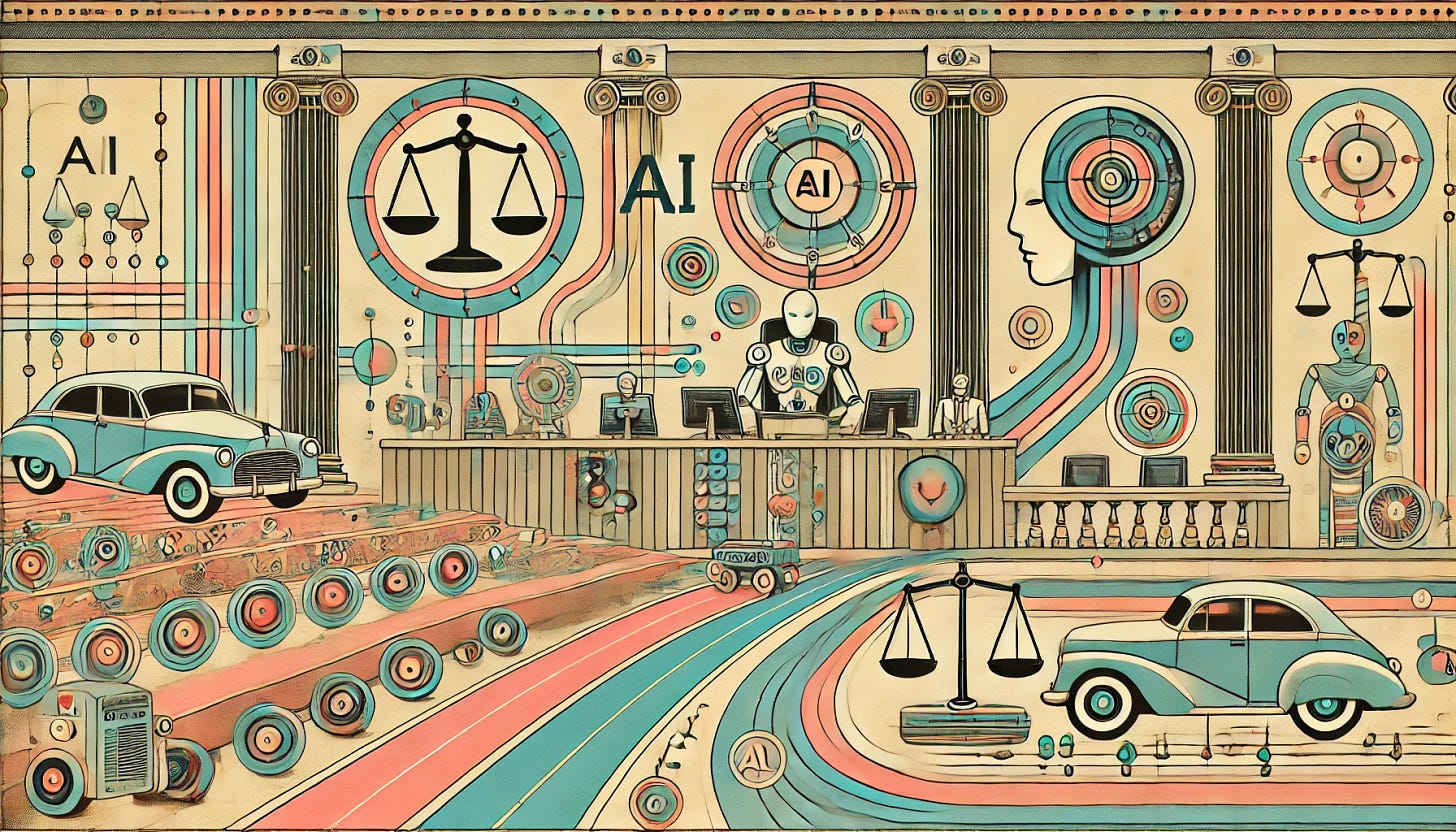How AI and Blockchain Rewrote Justice in the late 2020s
How a simple experiment with AI-drafted court rulings led to self-enforcing laws, blockchain justice, and the end of legal loopholes as we knew them.
By now, in 2037 most of us take it for granted that laws don’t just exist on paper, subject to human interpretation, argument, and occasional loophole gymnastics. They execute themselves. They live in code. They are, for lack of a better term, alive—running in the background, adjusting in real time, responding to society like an immune system rather than a set of stone tablets waiting to be broken. Looking back, the transition to this world was inevitable, but at the time, it felt like we had walked blindly into a sci-fi novel with no clear ending.
It started with a simple premise: What if laws weren’t just written, but programmed? What if legislation could self-enforce, with no need for courts to drag out disputes over intent or loopholes? Back in the early 2020s, before self-executing legal frameworks became the norm, law was still a deeply human affair. Judges debated the meaning of words, lawyers found creative ways to interpret old statutes, and entire legal battles hinged on parsing a single misplaced comma. It was, in retrospect, a charmingly chaotic way to govern billions of people.
Then came the AI.
It started as an experiment—just a test to see if an AI could draft legal opinions at the level of the U.S. Supreme Court. In 2024, an attorney, Ralph Losey, fed case briefs into a machine-learning model, asking it to generate a decision as if it were a sitting justice. To everyone’s surprise (and slight horror), the AI’s ruling was indistinguishable from those written by actual judges. Not only did it predict the real decision with eerie accuracy, but it even mimicked the distinct legal reasoning styles of different justices. Some called it a fluke. Others called it the beginning of the end.
At the same time, AI was creeping into legislatures. In Brazil, an unsuspecting city council accidentally passed a law drafted entirely by ChatGPT without realizing it. The ordinance, meant to regulate water meter replacements, was mundane, effective, and—crucially—undetectably artificial. Once the truth came out, there was an uproar. Some hailed it as proof that AI could remove bias and inefficiency from governance. Others worried that if an AI could write water laws today, what would stop it from rewriting criminal codes tomorrow?
That question answered itself by 2028 when a coalition of legal scholars, technologists, and policymakers proposed the first fully self-executing legal framework. They weren’t just talking about AI drafting laws. They wanted code to become law—not in the metaphorical sense, but in the most literal way possible. Instead of passing laws and relying on courts to interpret them, they would write legislation as smart contracts on a blockchain. These laws wouldn’t just sit in books; they would enforce themselves.
By 2031, the first machine-enforceable law went live in Estonia. It governed property transactions, ensuring that titles transferred automatically when conditions were met.
No middlemen.
No disputes.
The moment a purchase was finalized, the blockchain recorded the change, tax calculations executed themselves, and ownership shifted—no lawyers necessary. Other governments watched, intrigued.
The floodgates opened in 2033 when Singapore took it further: corporate taxes became self-collecting. Instead of businesses filing returns, revenue data was fed directly into an AI-run tax code, and payments were automatically deducted.
No audits.
No loopholes.
Just a constant, precise flow of tax revenue. And when companies inevitably tried to game the system, the AI adapted in real-time, patching tax code exploits like a cybersecurity update.
Of course, not everyone loved the new order. Lawyers and lobbyists, who had built careers around exploiting human language's ambiguities, were suddenly facing obsolescence. The world of endless appeals and legal gymnastics was being replaced by an era where what the law says and what the law does were finally the same thing. In this new reality, bribing an official to ignore a regulation was as pointless as trying to bribe a traffic light to stay green.
Resistance peaked in 2035, when the United States attempted to ban AI from playing any role in drafting federal laws. But by then, the train had already left the station. Most state governments had already adopted some form of algorithmic governance, using AI to draft clearer laws and blockchain to automate their enforcement. The federal government’s attempts to slow the transition were akin to trying to ban the printing press because it made scribes unemployed.
Looking back, the shift to self-enforcing laws was as much about necessity as it was about innovation. Human-led governance had simply become too inefficient, too prone to manipulation. When the legal system moved to automation, society didn’t descend into dystopia—it became fairer, faster, and more transparent. People stopped fearing loopholes that let the rich and powerful escape accountability. Government programs became impossible to defraud. Justice, at last, became predictable.
And yet, even in this age of machine-enforced law, we still have judges. We still have legislators. But their roles have changed. They no longer spend their time writing legalese that will be fought over in courtrooms for decades. Instead, they guide the intent of the law, defining the moral and social goals that the machines then execute. They steer the ship; the AI just makes sure it doesn’t hit the rocks.
We didn’t lose democracy. We just made it work better.
And to think—it all started with an AI that just wanted to draft a Supreme Court ruling.
[Image credit: AI Brand Photographer at FOMO.ai. Dax Hamman is the Co-Founder & CEO @ FOMO.ai]


